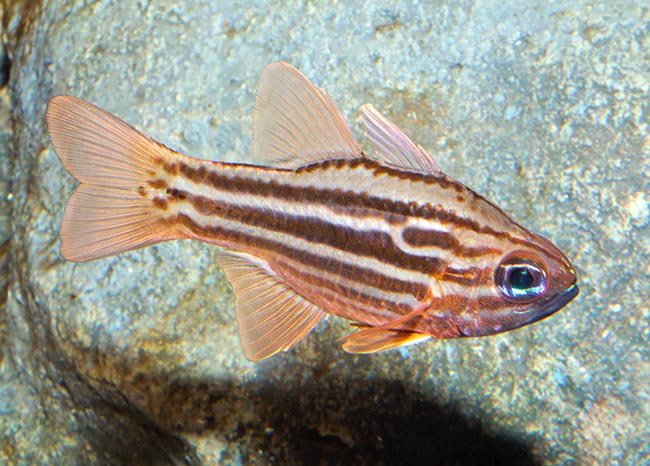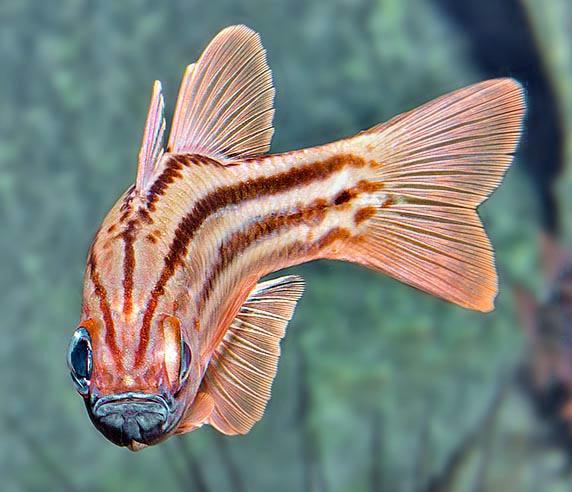Family : Apogonidae

Text © Giuseppe Mazza

English translation by Mario Beltramini

Ostorhinchus compressus, not frequent in aquaria, is mainly active by night © Giuseppe Mazza
The etymology of the genus comes from the Greek “osteon” = bone and “rygcos” = beak, due to the bony jaws, very much advanced and jagged, which take the place of the teeth.
The name of the species comes from the Latin “compressus” = narrow, because its body is rather flat and less high than other Apogonidae.
Zoogeography
It lives in the tropical waters of the Western Pacific Ocean and in the adjacent zones of the Indian Ocean. As an indication, we find it in Malaysia, Indonesia, New Guinea, Philippines, Taiwan and in the Japanese islands of Ryukyu. Southwards, it has colonized the Australian Great Barrier Reef, the Solomon Islands, the Vanuatu Islands and New Caledonia.
Ecology-Habitat
It moves around among the corals at low depths, as it never goes down more than 20 m.

It has big eyes with blue iridescences and very low vulnerability index © Giuseppe Mazza
The Ostorhinchus compressus can reach the 12 cm, great caudal fin included, but, usually, it barely exceeds the 8 cm.
In its whole it recalls the Apogon imberbis. On the back we note two fins. The first, triangular and smaller, is armed with 7 spiny rays, whilst the second one counts 1 spiny ray and 9 soft rays. The anal fin, almost symmetrical, has 2 spiny rays and 9 soft; the pectoral ones have 13-14 unarmed rays and the causal shows two great lobes.
The background colour, which interests also the more or less the translucent fins, is white-pink with shades of bronze and on this we note six brown ochrous horizontal stripes which transform in spots in the caudal zone. The great eye, with typical blue iridescences, is in line with the nocturnal activity of the species.
Ethology-Reproductive Biology
The blue-eye cardinalfish spends the day hidden among the branches of the corals belonging to the genera Porites and Acropora, rich of spikes which keep away the aggressors. In the evening it gets out hunting small crustaceans, little worms and other benthic animals. It lives in small schools, but during the reproductive period, which in Australia stands between October and February, pairs take form. The males, as is usual among the Apogonidae, collect the fecundated eggs and keep them in their mouth for 3-5 days till the hatching moment comes. It has reproduced even in captivity, but it is not a frequent species in the aquaria due to the relatively modest livery and its nocturnal habits.
The populations are not affected by the deterioration of the reefs connected to the climate changes, do tolerate the pollution and can double their members in less than 15 months. The vulnerability index of the species is, therefore, very low: just 13 on a scale of 100.
Synonyms
Amia compressa Smith & Radcliffe, 1911; Apogon compressus Smith & Radcliffe, 1911; Apogonichthys macrophthalmus Bleeker, 1860.
→ For general information about FISH please click here.
→ For general information about BONY FISH please click here
→ For general information about CARTILAGINOUS FISH please click here.
→ To appreciate the BIODIVERSITY of BONY FISH please click here.
→ To appreciate the BIODIVERSITY of CARTILAGINOUS FISH please click here.
